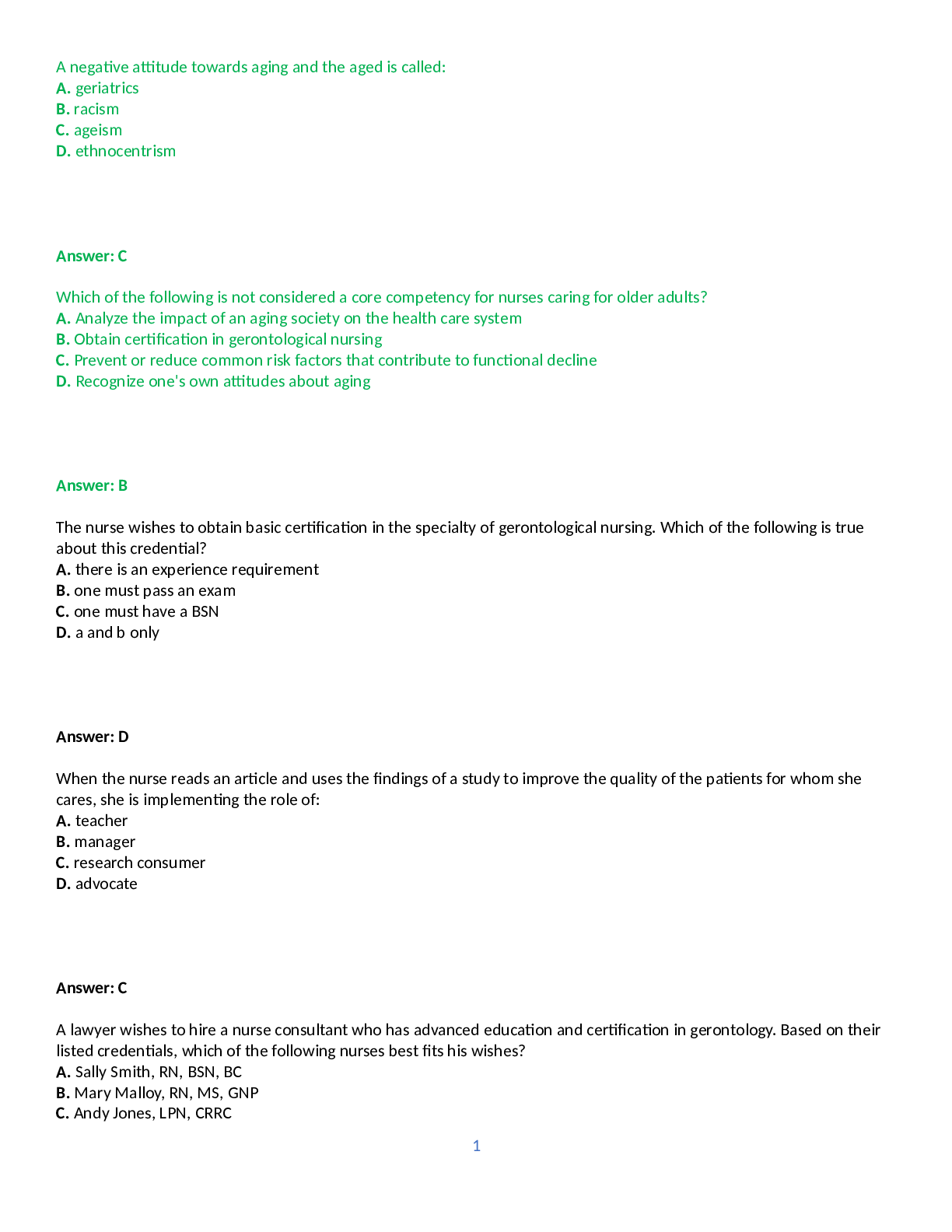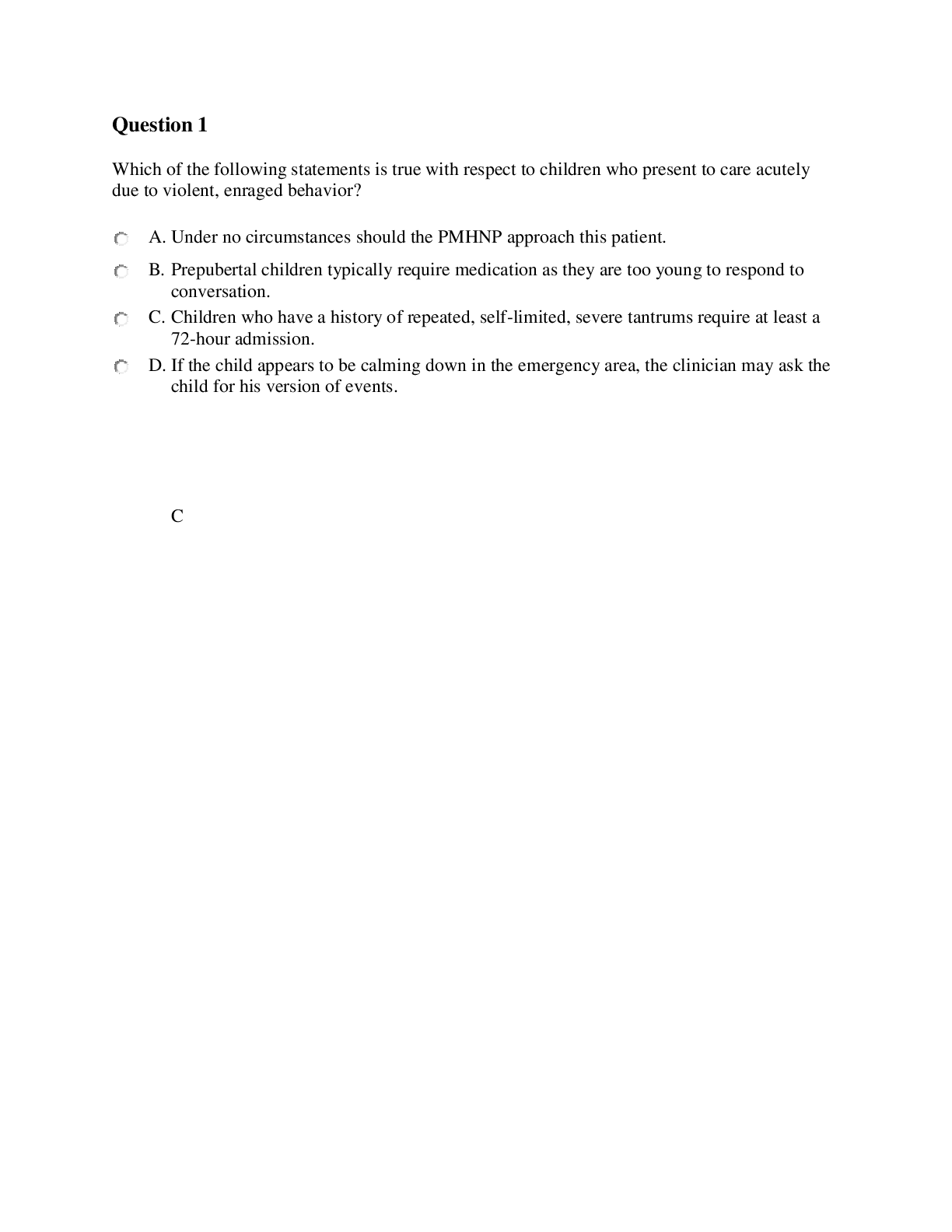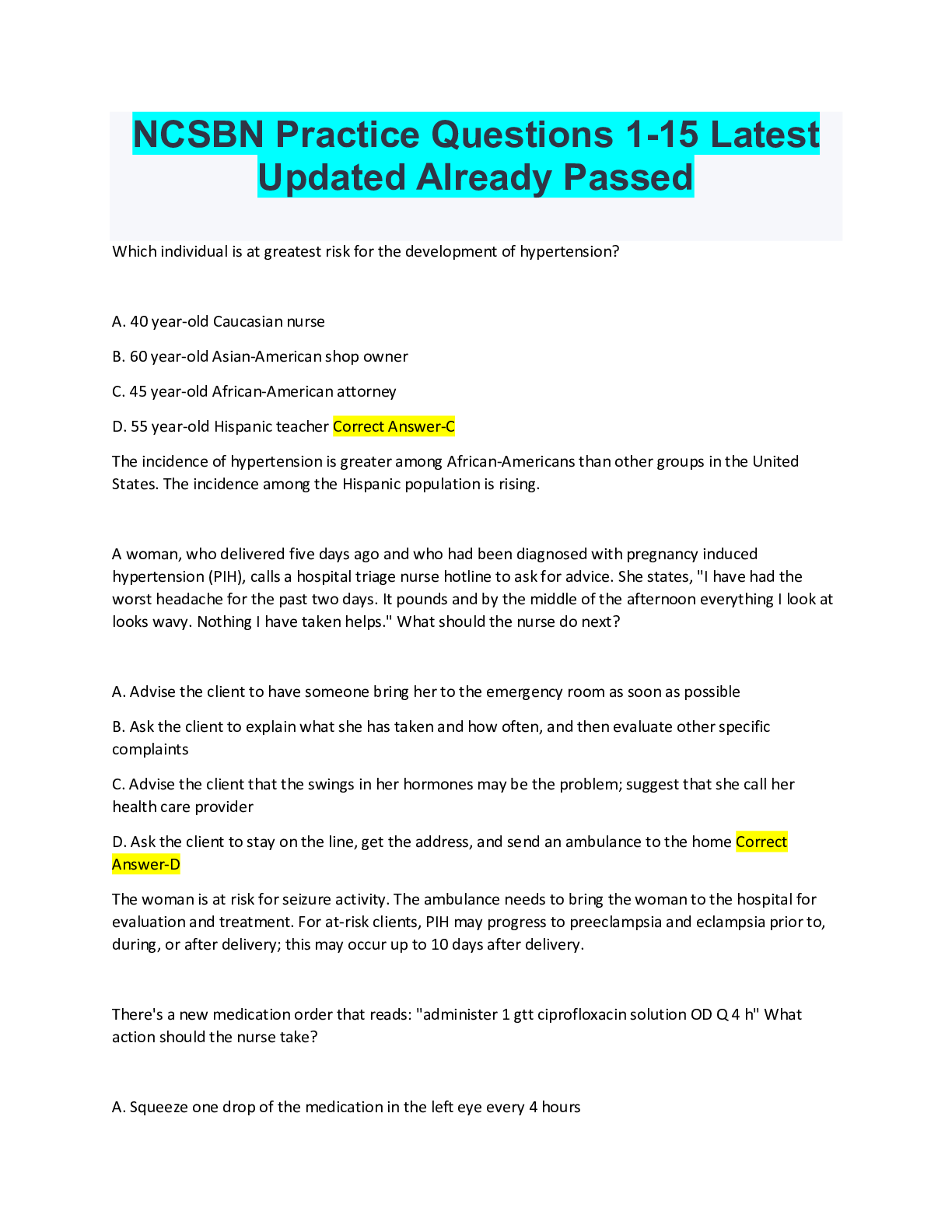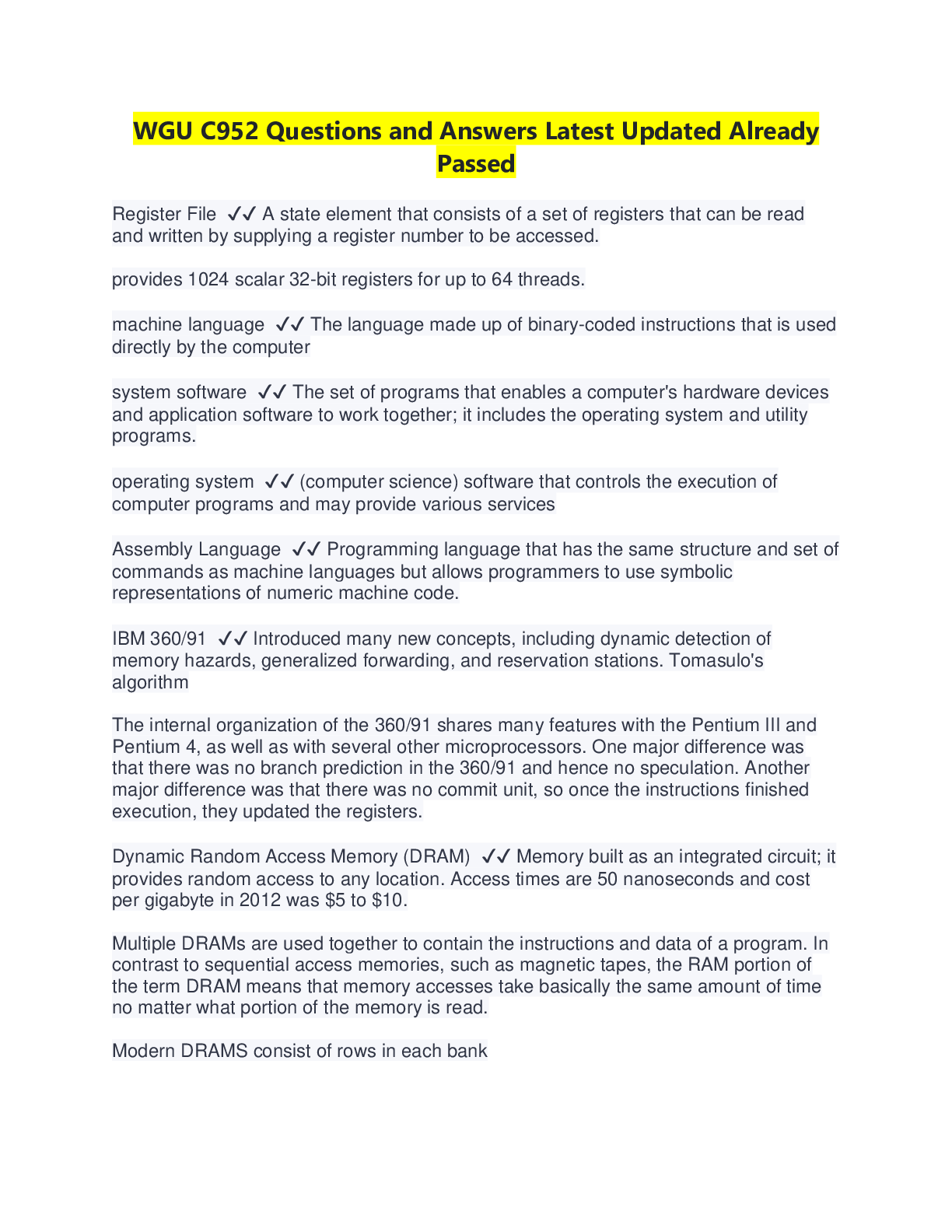Pharmacology > QUESTIONS & ANSWERS > NURSING 104 Pharmacology Quizlet--FINAL EXAM Latest Updated Already Passed (All)
NURSING 104 Pharmacology Quizlet--FINAL EXAM Latest Updated Already Passed
Document Content and Description Below
Pharmacology Final Study Guide Chapter 01: Drug Regulation, Actions, and Responses Workman & LaCharity: Understanding Pharmacology: Essentials for Medication Safety, 2nd Edition MULTIPLE CHOICE B... ASIC CONCEPTS 1. Which health care professional has the major responsibility for dispensing prescribed drugs under the direction of a pharmacist? a. Physician b . Nurse practitioner c. Licensed nurse d . Pharmacy technician ANS: D The physician and nurse practitioner have the major responsibility for prescribing drugs, not dispensing them. The licensed nurse has the primary responsibility for administering drugs, although under some circumstances a licensed nurse may dispense prescribed drugs but this is not his or her major responsibility in drug therapy. The pharmacy technician has the major responsibility of dispensing prescribed drugs under the direction of a licensed pharmacist. DIF: Cognitive Level: Remembering REF: p. 3 2. Which term describes the effect of a drug that improves body function? a. Side effect b . Intended action c. Adverse reaction d . Idiosyncratic response ANS: B The purpose of drug therapy is to take a drug to prevent, reduce, or correct a health problem. This response is any drug’s intended action also known as a therapeutic response. DIF: Cognitive Level: Remembering REF: p. 3 3. Which type of drug name is “owned” by the company that manufactures it? a. Generic name b Chemical name Pharmacology Final Study Guide . c. Category name d . Trade name ANS: D The chemical name is a drug’s exact chemical composition. The generic name is the name assigned to the drug by the U.S. Adopted Names Council and is not owned by anyone. The category name refers to the type of drug (what it does or what it is used for) and is not an actual drug name. The trade name (brand name) is the name provided and owned by a specific drug’s manufacturer. DIF: Cognitive Level: Remembering REF: p. 4 4. Which drug or drug class is a “high alert” drug? a. Penicillin b . Insulin c. NSAIDs d . Calcium ANS: B A high alert drug is one in which harm is likely to result if given at the wrong dose, to the wrong patient, or not given to the correct patient. Drugs classified as high alert drugs include potassium, narcotics (opioids), insulin, cancer chemotherapy drugs, and heparin (or any drug that strongly affects blood clotting). Penicillin, NSAIDs, and calcium are not considered high alert drugs. DIF: Cognitive Level: Remembering REF: p. 4 5. What is the term for a drug that has the same action as a naturally occurring body hormone or enzyme? a. Agonist b . Blocking agent c. Chemical d . Duplicator ANS: A A drug agonist is an extrinsic drug that activates the receptor sites of a cell and mimics the actions of naturally occurring body substances (intrinsic drugs). A blocking agent is a drug Pharmacology Final Study Guide antagonist. A chemical would not necessarily be a drug at all. A duplicator is not a pharmacologic term. DIF: Cognitive Level: Remembering REF: pp. 6-7 6. Which term describes how the body affects drug activity? a. Drug potency b . Pharmacodynamics c. Therapeutic effect d . Pharmacokinetics ANS: D The term pharmacokinetics refers to drug metabolism and how the body changes a drug. Pharmacodynamics refers to how a drug works to change body function. Drug potency refers to how strongly or to what degree a drug exerts its effects. The therapeutic effect is closer to pharmacodynamics, meaning how a drug works to change body function. DIF: Cognitive Level: Remembering REF: p. 10 7. In the United States, which group is responsible for enforcing established standards for drug manufacturing? a. U.S. Pharmacopeia b . National Institutes of Health c. Food and Drug Administration d . Association of Pharmaceutical Manufacturers ANS: C The standards for drug manufacture are established by the U.S. Pharmacopeia. These standards are enforced by the Food and Drug Administration. Neither the National Institutes of Health nor the Association of Pharmaceutical Manufacturers has any authority to enforce drug standards. DIF: Cognitive Level: Remembering REF: p. 5 8. Which factor is a major disadvantage of the transdermal drug delivery route? a. Only a prescriber can administer drugs by the transdermal route. b . Transdermal drugs must be sterile rather than clean. c. First pass drug loss by this route is the most extensive. d Drug absorption is dependent on adequate circulation. Pharmacology Final Study Guide . ANS: D Once a transdermal drug moves through the skin, it must enter the bloodstream to reach its target tissue. If circulation is poor to the area where the transdermal drug is applied, very little, if any, of the drug will reach its target tissue. DIF: Cognitive Level: Remembering REF: p. 12 9. How are intrinsic drugs different from extrinsic drugs? a. Intrinsic drugs are made by the body, whereas extrinsic drugs are made outside the body. b . Intrinsic drugs are administered by the parenteral route, whereas extrinsic drugs are administered by the oral route. c. Extrinsic drugs can only be applied to the skin or mucous membranes, whereas intrinsic drugs are taken internally. d . Extrinsic drugs require a prescription for administration, whereas intrinsic drugs are available over-the-counter. ANS: A Intrinsic drugs are the hormones, enzymes, and other chemicals made by the body that change cell activity. Extrinsic drugs are manufactured from chemical, animal, or plant sources and must have a means of entering the body in order to change cell activity. DIF: Cognitive Level: Understanding REF: p. 3 10. A patient asks why his drug to control high blood pressure has only one generic name and two different trade names. What is your best response? a. “Most drugs have different trade names that indicate different dosages.” b . “The two different trade names indicate that one is a more pure and safer drug than the other.” c. “The generic name is the actual official drug name and the trade name is a brand owned by a specific manufacturer.” d . “If you have insurance, you can get the trade name drug, which is usually more expensive than the generic named drug.” ANS: C The generic name is the name assigned to the drug by the U.S. Adopted Names Council and is not owned by anyone. The trade name (brand name) is the name provided and owned by a specific drug’s manufacturer. More than one manufacturer can make and sell the same drug at the same time under a different trade name. Regardless of trade name, all drugs that have the same generic name must be alike in their chemical composition and strength. DIF: Cognitive Level: Applying or Higher REF: pp. 3-4 Pharmacology Final Study Guide 11. How are the terms drug and medication different in the health care environment? a. Medications must be prescribed, whereas drugs are available over-the-counter. b . Medications are used to treat health problems, whereas drugs can be misused. c. Drugs are always illegal, whereas medications are legal. d . There is no difference between these two terms. ANS: D Although the lay public may think there is a distinction between these two terms, in health care they mean the same thing. Both are used to treat health problems and both can be misused. DIF: Cognitive Level: Understanding REF: p. 2 12. The prescriber tells a patient with allergies to use oral diphenhydramine (Benadryl) overthe-counter (OTC) to help manage her symptoms. She tells you that she would rather have a prescription for the “real” Benadryl because she knows it is stronger and will work better than the nonprescription form. What is your best response? a. “If you receive a prescription for this drug your name will be added to a controlled substances list.” b . “It is better to use the OTC Benadryl rather than the prescribed form because it has fewer side effects.” c. “The OTC form of Benadryl is the same strength as the one that was available by prescription only.” d . “You are correct. I will ask the health care provider to write a prescription so that you can get the most effective drug.” ANS: C Diphenhydramine (Benadryl) is no longer available by prescription only. The OTC form has the same strength, action, and side effects that the prescription only drug had. DIF: Cognitive Level: Applying or Higher REF: p. 4 13. Why is it important to always ask a patient about his or her use of any herbal supplements or botanicals? a. Many states do not have regulations about herbal supplements or botanicals. b . These substances are illegal and their use by patients must be reported. c. Patients who use botanicals seldom take their prescribed drugs. d . These substances can interact with a prescribed drug. Pharmacology Final Study Guide ANS: D Many herbal supplements and botanicals have effects on cell activity. Sometimes these agents can make drug side effects worse or can reduce the effectiveness of a prescribed drug. Others can actually cause health problems. DIF: Cognitive Level: Understanding (Comprehension) REF: p. 5 14. How are the effects of naturally occur [Show More]
Last updated: 1 year ago
Preview 1 out of 418 pages
Instant download

Buy this document to get the full access instantly
Instant Download Access after purchase
Add to cartInstant download
Reviews( 0 )
Document information
Connected school, study & course
About the document
Uploaded On
May 06, 2022
Number of pages
418
Written in
Additional information
This document has been written for:
Uploaded
May 06, 2022
Downloads
0
Views
60

.png)
.png)
.png)
.png)
.png)
.png)
.png)
.png)
.png)
.png)
.png)


.png)



.png)
.png)
.png)
 Latest Updated Already Graded A+.png)


